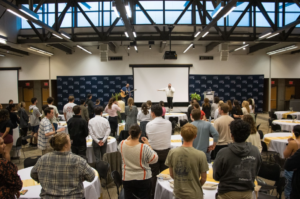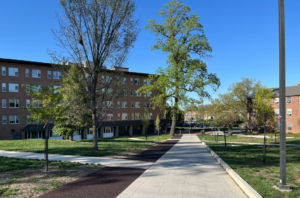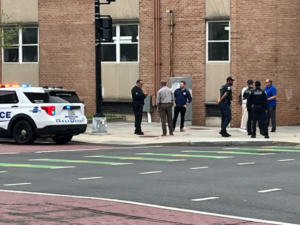Sustainability on Campus: How Does Catholic University Recycle?
By Jessica Fetrow
October is Campus Sustainability Month, and one of the most visible and impactful aspects of campus sustainability is recycling. This leads to the question: Does Catholic University recycle? If yes, how does it all work?
As stated on the facilities website page, “The Catholic University of America is committed to supporting a sustainable environment on campus in its landscaping, facilities maintenance, construction projects, energy use, and waste management.”
Furthermore, “paper, cans, bottles, metal, and cardboard all go into the same recycling bins. How you recycle in residence halls is how you recycle in classrooms, offices, the Edward J. Przybyla University Center and everywhere else on campus. It all gets sorted and separated at WB Waste Solutions’ sorting facility.”
Recently, there has been speculation among students as to whether or not Catholic University actually recycles, and what happens with recyclable materials disposed of on campus.
“Actually a while back in the Pryz, I went to compost something and the employee, who was taking the trash out at the time, told me to toss it in the ‘landfill’ section,” said Catholic University sophomore Shannon Miekka. “I told him it was compostable and he said, ‘It doesn’t matter, we don’t even do that anymore.’ He explained that they did sort out the recycling/landfill/compost years ago but now it all goes the same place.”
Although there has been much speculation and confusion regarding recycling procedures on Catholic University property, Alexandra Harry, Assistant Director of Campus Facilities and Sustainability Initiatives, assures that recycling procedures on campus are consistent and regulated.
“Yes, Catholic University recycles,” Harry said. “Catholic U’s custodial staff pulls all waste from the trash and recycling collection bins in all campus buildings and grounds. Recycling and trash are both bagged in a color-coordinated way, with recycling in blue bags, and landfill in black bags,” continued Harry. “This is for easy transport to the University’s central collection area at the Grounds/Fleet Maintenance Complex. From there, the waste hauler picks the trash and takes it to their facilities.”
The containers are then taken by the University’s recycling hauler WB Waste Solutions to either the Federal IPC 1220 W St NE for trash or Olive St Processing Center in Capitol Heights, MD for recycling. Both of these locations are owned by WB Solutions. The containers are taken to the transfer stations “as frequently as containers fill up,” which is “typically” three to five times per week. At the recycling location, the bags are all opened and sorted again for items that should be recycled and items that should be landfilled.
According to Harry, as of 2019, 331 tons of waste were recycled, which is a diversion rate of 28%.
Materials that can be recycled include paper products, flattened cardboard, plastic cups and containers, steel and aluminum bottles, cans and containers, and glass bottles and jars. Materials that are unable to be recycled include plastic bags, K-cups, hybrid packaging (i.e. metal/paper/plastic mix), chip bags and candy wrappers, hot coffee cups, tissue paper, polystyrene or styrofoam, plastic straws, plastic utensils, paint cans, ceramics, and dirty pizza boxes.
In addition to recycling, Catholic University has been taking other approaches to create a sustainable campus. Catholic University offers various methods of eco-friendly transportation alternatives to cars, such as “bicycles, campus shuttles, Metrorail, [and] Metrobus, which reduces the University’s carbon footprint,” according to the facilities webpage. Additionally, Catholic University owns the largest solar installation in the Washington, D.C., metropolitan area, and “has been recognized as one of the most environmentally responsible colleges in North America.”Catholic University students can follow along with the university’s efforts to maintain an environmentally-conscious campus through their social media accounts, @green_cua on Twitter and @cuasustainability on Instagram.








